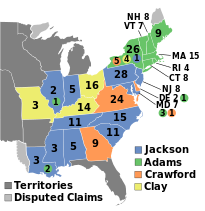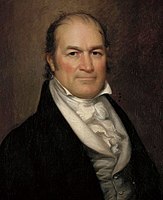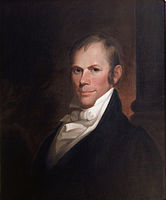| |||||||||||||||||||||||||||||||||||||||||||||||||||||||||||||||||||||||||
261 members of the Electoral College 131 electoral votes needed to win | |||||||||||||||||||||||||||||||||||||||||||||||||||||||||||||||||||||||||
|---|---|---|---|---|---|---|---|---|---|---|---|---|---|---|---|---|---|---|---|---|---|---|---|---|---|---|---|---|---|---|---|---|---|---|---|---|---|---|---|---|---|---|---|---|---|---|---|---|---|---|---|---|---|---|---|---|---|---|---|---|---|---|---|---|---|---|---|---|---|---|---|---|---|
| Turnout | 26.9%[1] | ||||||||||||||||||||||||||||||||||||||||||||||||||||||||||||||||||||||||
| |||||||||||||||||||||||||||||||||||||||||||||||||||||||||||||||||||||||||
 Presidential election results map. Blue denotes states won by Jackson, green denotes those won by Adams, orange denotes those won by Crawford, light yellow denotes those won by Clay. Numbers indicate the number of electoral votes allotted to each state. | |||||||||||||||||||||||||||||||||||||||||||||||||||||||||||||||||||||||||
| |||||||||||||||||||||||||||||||||||||||||||||||||||||||||||||||||||||||||
1825 contingent U.S. presidential election | |||||||||||||||||||||||||||||||||||||||||||||||||||||||||||||||||||||||||
| |||||||||||||||||||||||||||||||||||||||||||||||||||||||||||||||||||||||||
24 state delegations of the House of Representatives 13 state votes needed to win | |||||||||||||||||||||||||||||||||||||||||||||||||||||||||||||||||||||||||
| |||||||||||||||||||||||||||||||||||||||||||||||||||||||||||||||||||||||||
House of Representatives votes by state and district. States and districts in orange voted for Crawford, states and districts in green for Adams, and states and districts in blue for Jackson. | |||||||||||||||||||||||||||||||||||||||||||||||||||||||||||||||||||||||||
The 1824 United States presidential election was the tenth quadrennial presidential election. It was held from Tuesday, October 26 to Thursday, December 2, 1824. Andrew Jackson, John Quincy Adams, Henry Clay and William Crawford were the primary contenders for the presidency. The result of the election was inconclusive, as no candidate won a majority of the electoral vote. In the election for vice president, John C. Calhoun was elected with a comfortable majority of the vote. Because none of the candidates for president garnered an electoral vote majority, the U.S. House of Representatives, under the provisions of the Twelfth Amendment, held a contingent election. On February 9, 1825, the House voted (with each state delegation casting one vote) to elect John Quincy Adams as president, ultimately giving the election to him.[2][3]
The Democratic-Republican Party had won six consecutive presidential elections and by 1824 was the only national political party. However, as the election approached, the presence of multiple viable candidates resulted in there being multiple nominations by the contending factions, signaling the splintering of the party and an end to the Era of Good Feelings, as well as the First Party System.
Adams won New England, Jackson and Adams split the mid-Atlantic states, Jackson and Clay split the Western states, and Jackson and Crawford split the Southern states. Jackson finished with a plurality of the popular vote, and also of the electoral vote (due to the Three-fifths Compromise), while the other three candidates each finished with a significant share of the votes. Clay, who had finished fourth, was eliminated. Adams was the first son of a former president to become president, something later repeated by George W. Bush in 2000.
This is one of two presidential elections (along with the 1800 election) that have been decided in the House. It is also one of five elections in which the winner did not achieve at least a plurality of the national popular vote and the only election in which the candidate who received the most electoral votes from the Electoral College did not win the election. It is also, to date, the election with the lowest popular vote percentage for an elected president (32.7%).
- ^ "National General Election VEP Turnout Rates, 1789-Present". United States Election Project. CQ Press.
- ^ Robin Kolodny, "The Several Elections of 1824." Congress & the Presidency: A Journal of Capital Studies 23#2 (1996) online[dead link].
- ^ George Dangerfield, George. The Awakening of American Nationalism: 1815-1828 (1965) pp 212–230.
Cite error: There are <ref group=lower-alpha> tags or {{efn}} templates on this page, but the references will not show without a {{reflist|group=lower-alpha}} template or {{notelist}} template (see the help page).








